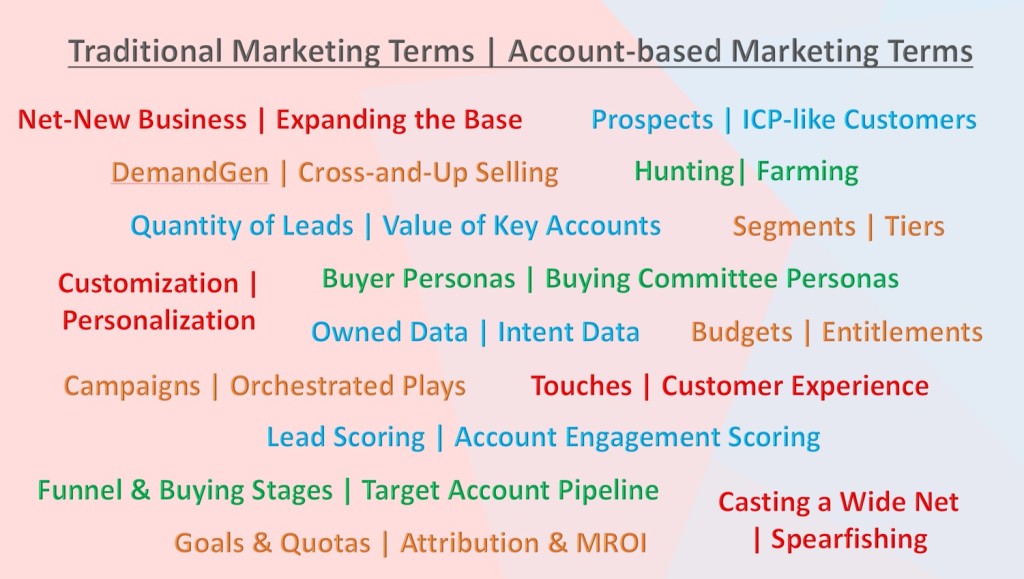
As a Senior B2B Marketing Strategist at The Pedowitz Group, I coach large enterprises through transformational change such as moving from traditional marketing towards Account-based Marketing. Prospecting is challenging in the “new normal”, so ABM initiatives are becoming increasingly common as enterprises focus more resources on building more value from their customer base. But many marketers are unclear about the differences between traditional demand-gen marketing and account-based marketing . They need help learning to fish.
At the highest level, Account-based Marketing is a discipline like Demand Generation. But while demand-gen typically focuses on gaining net-new business, ABM works to expand the client base. Instead of trying to nurture prospects into a first-time purchase, ABM tries to nurture existing customers into buying more and renewing. Usually, ABM’s focus is on increasing the life-time value of customers most like your Ideal Customer Profile (or ICP).
So while Marketing is often synonymous with Demand Generation, ABM is about cross-selling and up-selling to your base. That’s similar to the difference between “hunting and farming” in sales lingo.
With the focus on known accounts comes a different taxonomy and different ways to measure value. The ABM team is measured by the value of the key accounts it expands, versus the quantity of MQLs it produces. To increase key account LTV, Marketing must look not only at segments but at account tiers. Typically, ABM has at least three tiers: 1:many (for which content and channels are customized–often by industry), 1:few (with a mix of customization and account personalization), and 1:1 (with personalization by account and even by contact.) The most effective personalization responds to a client’s specific challenges and pain points.
Buyer personas are still important in ABM, but ABM also focuses on Buying Center Personas. Enterprises often have multiple personas involved in a large purchase. Instead of just nurturing the champion, ABM campaigns often include outreach to Influencers and Ratifiers from Legal, Procurement, Security, and IT – each of whom have very different information needs through the account’s buying journey.
Another key difference between Traditional marketing and ABM is that the former typically segments data you own or can access through software partners. In contrast, ABM technology tools (or ABMtech) are increasingly aggregating data from multiple third-party sources and using proprietary algorithms to surface the contacts most likely to be in the market for your solutions. Your company doesn’t own this intent data, but you can advertise to in-market contacts through the tools embedded in the ABMtech.
In marketing we use budgets to control spend per channel. In ABM we use entitlements to determine how much we’ll spend by tier and account. In both disciplines we run campaigns, but in ABM we include orchestration. These campaigns included scripted handoffs from marketing to inside and field sales so that the customer experience is continuous. So overall your organization is focused less on individual touches and more on maximizing the overall customer experience.
Even if you can identify in-market accounts, nurturing and scoring are still important (because just calling them would be creepy). But in ABM we measure account engagement scores. The AES shows response all known contacts within target accounts and shows if the company is doing research on you.
That shift necessitates a change in measurement. Instead of Marketing filling the funnel and Sales pulling deals out of the bottom, ABM monitors the entire pipeline for target accounts. That forces silo-busting and cooperation, though each team still needs to make goals and prove revenue contribution. ABMtech provides increased capabilities for revenue attribution by touchpoint.
So while ABM is largely focused on expanding the LTV of your base, ABMtech can also help identify in-market prospects and enable nurturing of net-new customers. ABM and DemandGen can and should be twin disciplines. As Jon Miller said while at Engagio, traditional marketing is like casting a wide net, and ABM is like spearfishing. It’s important to do both carefully so you don’t scare the fish. But come on in – the water is fine.
